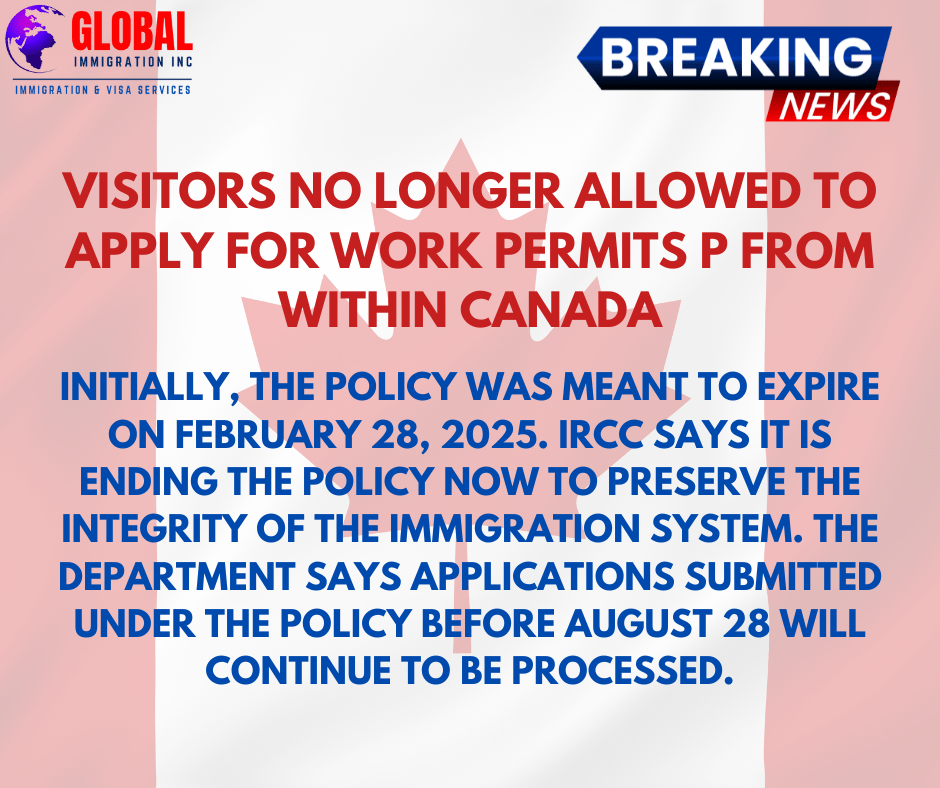Canada Ends Policy Allowing Visitors to Apply for Work Permits from Within the Country

The Canadian government announced that, effective August 28, 2024, the temporary public policy that allowed visitors to apply for work permits from within Canada has officially ended. This policy was initially introduced as a pandemic-related measure in August 2020 to address labor shortages and support economic recovery by providing businesses with greater access to workers who were already in the country.
Background of the Policy
The policy allowed foreign nationals who were in Canada as visitors (on temporary resident visas) to apply for an employer-specific work permit without having to leave the country. Under normal circumstances, visitors would have to leave Canada and apply for a work permit from outside the country, typically from their home country. The temporary measure aimed to fill labor gaps by tapping into the pool of visitors who were already in Canada and willing to work, reducing delays and streamlining the hiring process for employers.
Expiration of the Policy
As of August 28, 2024, this policy has expired, and the process has reverted to the pre-pandemic requirements. Visitors in Canada who now wish to obtain a work permit must follow the standard procedure, which involves:
- Exiting Canada: Visitors must leave the country before applying for a work permit. They can apply from their home country or another location outside of Canada.
- Application Process: The standard application process requires submitting a work permit application online or at a Visa Application Centre (VAC) outside of Canada. The applicant must provide all necessary documentation, including a valid job offer and a positive Labor Market Impact Assessment (LMIA), unless exempted under specific LMIA exemption categories.
- Re-entry to Canada: If the work permit is approved, the individual can re-enter Canada with their new status as a temporary foreign worker.
Impact on Employers and Workers
For employers, this change may mean longer processing times and additional steps to hire foreign workers, particularly if they were relying on the temporary policy to quickly bring visitors into the workforce. Employers will need to consider the extra time required for candidates to leave and re-enter Canada, which may affect hiring timelines.
For visitors currently in Canada who were planning to transition to a work permit under the expired policy, they will now need to reassess their options. They must either leave Canada and apply from abroad or explore other immigration pathways that might allow them to work in Canada.
Possible Alternatives
There are still some pathways available for those who wish to work in Canada, including:
- Express Entry Program: Visitors who qualify under one of the economic immigration streams (such as the Federal Skilled Worker Program, Canadian Experience Class, or Federal Skilled Trades Program) can enter the Express Entry pool and potentially receive an invitation to apply for permanent residence.
- Provincial Nominee Programs (PNPs): Some provinces may have specific streams or pilot programs that allow certain visitors to apply for work permits or permanent residency directly.
- Spousal Work Permits: Visitors who are spouses or common-law partners of Canadian citizens or permanent residents may be eligible for an open work permit under the family sponsorship program.
Conclusion
The expiration of this temporary public policy represents a significant shift in Canada’s immigration landscape, particularly for visitors who were considering a transition to the workforce while remaining in the country. It underscores the importance of staying informed about immigration policies and working closely with immigration professionals to explore the best available options based on individual circumstances.
If your company provides immigration services, this update is crucial for advising clients, particularly those who were relying on the now-expired policy to transition from visitor status to a work permit holder.
